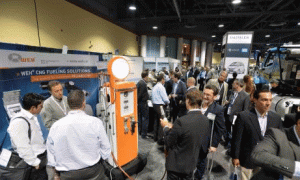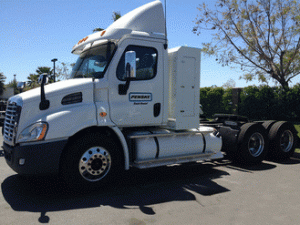 Alternative, clean transportation appears to be gaining support – as evidenced last week during ACT Expo 2014 at the Long Beach, Calif., convention center. Now in its fourth year since inception, the conference’s attendance was up – perhaps as many as 4,000 attendees, making it the largest event of its type in the US and perhaps the world. ACT Expo keynote speakers, workshops, ride and drive, and an expanded exhibit hall, featured the latest in alternative fuel vehicle technology, the regulatory environment, and cost-benefit analysis by fleets.
Alternative, clean transportation appears to be gaining support – as evidenced last week during ACT Expo 2014 at the Long Beach, Calif., convention center. Now in its fourth year since inception, the conference’s attendance was up – perhaps as many as 4,000 attendees, making it the largest event of its type in the US and perhaps the world. ACT Expo keynote speakers, workshops, ride and drive, and an expanded exhibit hall, featured the latest in alternative fuel vehicle technology, the regulatory environment, and cost-benefit analysis by fleets.
ACT Expo has become something of a broad platform for fuels, vehicles, and technologies of all types to be well represented, and for stakeholders in these industries to network. The American Trucking Associations worked with organizers of the event for the first time this year; NAFA Fleet Management Association also played a key organizing role along with the US Dept. of Energy’s Clean Cities, the US Environmental Protection Agency (EPA), and the EPA’s SmartWay Transport Partnership.
Another innovation launched this year was co-located events. Propane Education & Research Council was one of the leading sponsors of the event and held its “Lead the Way” propane autogas summit; NGV Global held its annual conference in tandem with ACT Expo and led a Technical Forum; California Hydrogen Business Council held its spring summit there; “Alternative Fuel Toolkit for Local Governments, Fleet Managers, and Employers Workshop” was presented by another leading sponsor, South Coast Air Quality Management District; and “Women in Alternative Clean Transportation Summit” was organized by ACT Expo management firm Gladstein, Neandross & Associates. There were a few field trip events coordinated with ACT Expo as well, including a heavy-duty natural gas tour with site visits to the Clean Energy station at Port of Long Beach and the Waste Management Carson station featuring LNG and CNG fueling.
The kickoff keynote speaker during Tuesday’s luncheon was Dennis Slagle, executive vice president group truck sales & marketing Americas, Volvo Group. The truck manufacturer aims to be the world leader in sustainable transportation through its Volvo, Mack, UD, Prevost, Novobus, and other heavy duty truck and bus brands. Volvo operates a comprehensive green vehicle portfolio in transport with natural gas, clean diesel, dimethyl ether (DME), and bi-fuel vehicles. Volvo is working with Cummins on bringing in a 13 liter LNG engine next year. Slagle called for a common sense regulatory approach in Washington, and asked for renewal of expired tax incentives.
Erik Neandross, CEO of event organizer Gladstein, Neandross & Associates, led a panel right after Slagle’s presentation featuring prominent leaders in the industry. Clean Energy Fuels president and CEO Andrew Littlefair gave some interesting statistics including heavy duty trucks using 25 billion gallons of natural gas last year, taking the lead, by far, as a user category. There are 19 million natural gas vehicles in operation globally today, but only 142,000 are in the US. There is a lot happening out there, and Littlefair made reference to supermarket giant Kroger’s announcement that day on how it replaced 40 diesel trucks with that same amount of LNG trucks in Oregon.
Propane Education & Research Council (PERC) president and CEO Roy Willis said that in addition to light and medium duty trucks, propane is being widely used in material handling, generators, irrigation, and landscaping (such as mowers). There are about 600,000 propane-powered forklifts in operation in the US. There are about 140,000 propane-powered passenger and commercial vehicles on US roads; as for sales, there were about 14,000 units sold in the US last year (about half OEM and half conversion); 75% are light duty (mostly pickups and police cars) and 25% are medium duty including school buses. PERC forecasts that there will about 18,500 propane autogas vehicles sold in the US this year and about 25,000 in 2015. In a separate interview, Willis said there’s a strong sense of momentum being experienced in propane autogas, even with expiration of the fuel tax credit at the end of 2013. Direct injection engines are holding a lot of promise; Willis talked about the PERC project with Southwest Research Institute, Ford, General Motors, and Hyundai on direct injection.
National Biodiesel Board CEO Joe Jobe talked about the ongoing battle in Washington – and how oil industry spokespeople are lobbying with misinformation about the Renewable Fuel Standard (with examples being shown in video segments) while also covering up their abundant federal subsidies. States are opening up to biodiesel such as Minnesota mandating that 10% of its diesel will soon be biodiesel. Via Motors chairman of the board Bob Lutz championed the breakthroughs electric vehicles are on the cusp of experiencing. He said that next-gen, lithium-sulfur batteries will have five times as much energy density as lithium-ion batteries.
Alex Freitag, director of diesel systems engineering at Robert Bosch, led a panel on light-duty diesel as a growing alternative. The 20% to 30% of fuel efficiency gains, along with huge reductions in NOx, hydrocarbons and particulate matter, have made diesel-powered vehicles much more viable for fleets and for consumers in the US. Mike McGarry, fleet product planning manager and green fleet support at General Motors, and William Craven, general manager of regulatory affairs at Daimler AG/Mercedes-Benz, discussed investments OEMs are making in clean diesel options. Advancements are being made in diesel technology, Freitag said, including thermodynamic optimization, turbochargers, idle reduction, and stop-start systems. As for biodiesel, OEMs are supportive of the alternative fuel but need to feel confident in the quality of the fuel before they embrace it, McGarry and Craven said.
ACT Expo 2014 hosted a ride and drive on Wednesday afternoon last week. Vehicles included an EVI medium-duty electric truck and a VIA Motors eRev extended range van; a propane-powered Ford E-Series van; fuel cell vehicles such as the Mercedes F-Cell and Honda FCX Clarity; natural gas vehicles such as the Honda Civic Natural Gas and Volvo VNL CNG tractor; and two clean diesel vehicles – the Chevrolet Cruze Turbo Diesel and Chrysler Jeep Grand Cherokee with EcoDiesel.

